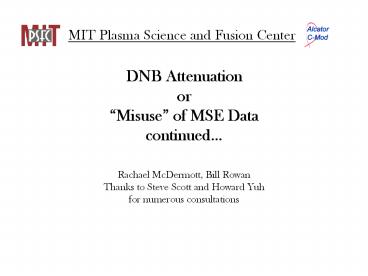DNB Attenuation or - PowerPoint PPT Presentation
1 / 8
Title: DNB Attenuation or
1
DNB AttenuationorMisuse of MSE
Datacontinued
MIT Plasma Science and Fusion Center
- Rachael McDermott, Bill Rowan
- Thanks to Steve Scott and Howard Yuh
- for numerous consultations
2
What and Why?
- Using MSE data to find accurate estimates of
neutral beam attenuation - These measurements can be used to benchmark beam
penetration codes currently in use. - Accurate knowledge of neutral density is
necessary for calculations of impurity densities
in the plasma.
3
Last time we
- Found a set of channel-to-channel calibration
factors for the MSE diagnostic - Used these factors to derive relative beam
attenuations from the MSE signal for beam into
plasma shots
To Do List from last time
- Understand the calibration at all pressures.
- Compare the attenuations to standard results
from the literature and from our own penetration
code
4
Calibration Constants
Shot 002 003 004 005 006
Pressure (mT) 2.45 1.215 .5939 .5903 .2697
Channel (m)
.86786 1.00000 1.00000 1.00000 1.00000 1.00000
.85243 0.352164 0.58445 0.717148 0.708050 0.803426
.83575 0.196582 0.55356 0.949377 0.92907 1.23440
.81979 0.039039 0.19822 0.42616 0.414802 0.605755
.78509 0.00438422 0.0736256 0.288886 0.283944 0.542222
.76645 0.00151599 0.0490210 0.260984 0.249218 0.551441
.74647 0.000307003 0.0191607 0.143248 0.133928 0.321710
.72641 0.000171313 0.0213610 0.24522 0.230223 0.664743
.70109 2.73887e-05 0.00777271 0.127916 0.112520 0.347466
.67594 5.02186e-06 0.00373183 0.086171 0.0745174 0.222317
- Due to a calculation error, the calibration
constants presented at the last presentation were
incorrect. The correct (hopefully) constants are
shown above. - We still dont have an explanation for the
discrepancies between the pressures. The lowest
pressure constants are used for the beam density
calculation.
5
Comparison to Literature
- An analytical fit to the stopping cross-section
for a neutral beam into a hydrogen plasma as
derived by Janev is - A theoretical beam attenuation can be derived
from this as follows
Janev, R.K., Boley, C.D., Post, D.E. (1989)
PENETRATION OF ENERGETIC NEUTRAL BEAMS INTO
FUSION PLASMAS. NUCLEAR FUSION, Vol. 29, No.12,
2125-2139
6
Decay Constants
- All of the attenuation curves were fit to
The
values of the parameters for two shots are given
in the table below. - As the level of impurities is increased in the
predicted model so does its agreement with the
MSE attenuation.
Shot MSE No Impurities 1C 2C
1040409007 a -0.036409910 -0.078569204 0.071894864 -0.067443145
1040409007 ß 1.1521804 1.1679132 1.1600576 1.1541364
1040409007 ? 0.12570610 0.16726451 0.16841049 0.17047122
1040505029 a -0.13186031 -0.1694330 -0.16218624 0.15475712
1040505029 ß 1.3511533 1.4181084 1.4075826 1.3967821
1040505029 ? 0.15018593 0.13794946 0.13883806 0.13977914
7
Prediction and Experiment
The predicted beam attenuation for each shot is
calculated using the CMOD temperature, and
density profiles. The temperature profile was
obtained from ECE. The density profile was
obtained from the Visible Bremsstrahlung
diagnostic.
- An MSE derived beam attenuation along with its
corresponding Janev-predicted beam attenuation is
pictured above. This is for shot 1040505029.
8
Conclusions
- An astonishing 39 of 41 shots fit well to
exponential curves and were consistent with
predicted results.
To Do List
- Explain calibration constant variation with
pressure. Find another way to derive a
channel-to-channel MSE calibration. - Include an error analysis in the derivation of
the densities. - Include a measure of the difference between the
calculated and predicted attenuations. - Finish writing this program in a user friendly
form that can be run after each shot.































